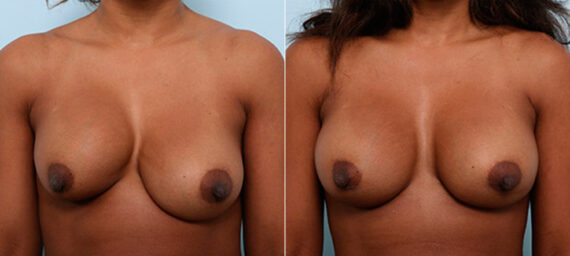35+ Years of Experience
3k+ Real Patient Reviews
10,000+ Breast Surgeries Performed
Texas Super Doctor
Breast Implant Revision in Houston
Breast implant revision is a surgical procedure that replaces old implants with new ones to address concerns that may prevent patients from being fully satisfied with their previous breast surgery. Dr. Vitenas, a highly sought-after, board-certified breast surgeon in Houston, brings over 35 years of plastic surgery experience to help you achieve results that better align with your aesthetic goals.

Breast Revision Before & After Photos




Each Patient is Unique and Individual Results May Vary
Discover why patients from across the U.S. and around the world choose Dr. Vitenas as the premier surgeon for naturally-appearing breasts.
What is Breast Implant Revision?
Breast implant revision is a procedure performed on patients who previously underwent breast augmentation. The procedure helps correct issues that have developed with the original implants.
Revision procedures may also be performed when a patient wants to alter the size, shape, or style of their implants. By replacing them, patients can achieve improved results that better match their aesthetic wishes.
Benefits of Breast Implant Revision
There are several potential benefits associated with undergoing an implant revision procedure:
- It enables patients to correct complications from their original augmentation, like capsular contracture, malposition, or rupture. This helps relieve discomfort and improves aesthetic results.
- For patients who are unhappy with their initial breast augmentation results, revision offers a chance to alter the implant size, shape, or style.
- Revision procedures can reposition implants that have shifted out of place over time into a more optimal position with better symmetry.
- In cases of rupture, leaking, or deflation, the problematic implants can be exchanged for intact replacements.
Types of Breast
Implant Problems
Various types of breast implant problems may warrant revision:
Bottoming Out & Stretch Deformity
Bottoming out is a condition where breast implants descend or shift downward on the chest, causing the nipples to appear higher on the breast mound than they should be. This can make the breasts look droopy due to the amount of breast volume ending up below the nipple. Bottoming out is often caused by a lack of integrity in the inframammary crease, which is the natural fold beneath the breasts.
Lateral Fold Malpositions
Symmastia
Symmastia, sometimes called “uni-boob,” is a complication where the implants are positioned too close together in the midline of the chest, causing the appearance of a single continuous breast mound instead of two separate breasts with a natural space between them.
The breasts may even touch, creating undesirable cleavage. Oversized implants and excessive medial pocket dissection often cause this.
Wrinkling and Rippling
Wrinkling and rippling are common terms used to describe certain cosmetic issues that can occur with breast implants. In some patients, the implant outline becomes visible through thin overlying breast tissue, creating an unsightly wrinkled appearance. This occurs more often with saline implants but can happen with silicone too. Changing implant type, size, or surgical technique may improve the visible rippling.
Capsular Contracture
Capsular contracture refers to the formation of excessive scar tissue around the breast implant, causing the tissue capsule to tighten and constrict around the implant. As the tissue contracts, implants may become painfully hard, misshapen, or malpositioned.

Dealing with Ruptured Implants
Saline breast implants tend to deflate quickly when ruptured, as the saltwater leaks out and is absorbed by the body. Silicone implants, however, do not deflate rapidly when the shell ruptures. Instead, the silicone filler material can remain trapped in the surrounding scar tissue capsule.
With silicone implants, signs of rupture may include breast swelling, hardening, and changes in breast shape or size. In some cases, ruptures are only detectable via medical imaging. However, Dr. Vitenas can often identify silicone implant ruptures through careful physical examination.
When rupture occurs, it is advisable to have the implants replaced promptly to avoid complications.
Am I a Candidate for Breast Implant Revision?
Ideal candidates for breast implant revision are healthy, non-smokers with realistic expectations for the procedure. Smoking can slow down the healing process after surgery, so it’s important to avoid it.
When breast implant revision is needed depends on dissatisfaction with previous results.
- Be dissatisfied with the appearance or feel of their breast implants
- Suspect that their implants may be ruptured
- Be experiencing complications like capsular contracture
- Wish to alter the size, shape, or style of their existing breast implants

The Breast Implant Revision Consultation
The first step is to schedule a breast implant revision consultation with Dr. Vitenas.
During the consultation, Dr. Vitenas will:
- Listen to your concerns about your existing breast implants
- Physically examine your breasts and implants
- Review your full medical history
- Take photographs of your breasts from multiple angles
- Discuss the potential benefits and risks of revision surgery
- Explain what you can expect from a breast implant revision procedure
- Review replacement implant options if you wish to exchange your implants
- Make recommendations regarding implant type, size, shape, and surgical techniques to help you achieve your goals
Preparing for Breast Implant Revision
- Discontinuing nicotine use for several weeks before and after surgery
- Stopping certain medications like blood thinners prior to surgery
- Undergoing breast imaging tests to evaluate the current implants
- Completing lab screening tests before the revision procedure
On the day of your revision procedure, arrange for someone to drive you to and from the surgical facility. Having someone available to assist you at home while recovering is also recommended.
Proper preparation helps ensure you are ready for your breast implant revision surgery and recovery.
The Breast Implant Revision Procedure
Dr. Vitenas performs breast implant revision surgery at his state-of-the-art accredited outpatient surgical facility. The procedure typically takes one to three hours and is performed under general anesthesia.
During the surgery, Dr. Vitenas will:
- Make an incision to access the breast implants (often in the breast crease)
- Remove the existing breast implants along with any scar tissue present
- Perform tissue rearrangement, capsular modifications, breast pocket adjustments, and other corrections as needed
- Insert the new breast implants and position them appropriately
- Use sutures to close the incisions
In some cases, Dr. Vitenas may place drains to help avoid fluid accumulation as you initially recover. He may also utilize dermal matrix products like Strattice to help support implants and minimize complications.
The specific techniques Dr. Vitenas uses will depend on your unique goals. The procedures can be customized to correct the issues that you are experiencing and provide improved aesthetic results.



Recovering from Breast Implant Revision
Initial recovery time usually lasts one to two weeks. Many patients can resume work activities within several days to a week after surgery.
Dr. Vitenas will provide detailed post-op instructions to support your recovery process. Follow-up appointments to monitor healing and remove any drains will be scheduled.
Exercise and strenuous activity are restricted for four weeks, while full healing typically takes six weeks. Most revision patients experience greatly improved outcomes and satisfaction after healing is complete.
Breast Implant Revision FAQ
What is breast revision surgery?
Breast revision surgery is performed as a secondary procedure to correct or improve the outcome of a previous breast augmentation surgery. It involves removing the existing breast implants and replacing them with new ones to fix issues and alter outcomes.
How much is breast implant revision surgery?
The exact price of breast implant revision surgery depends on the complexity and nature of the revision, fees for the surgical facility, anesthesia, and implant costs. During your consultation, Dr. Vitenas will provide you with an accurate price quote for your customized procedure.
Can breast implant revision achieve lift?
Yes, in many cases, a breast lift can be done in conjunction with implant revision to lift and reshape sagging breasts. This is known as an augmentation mastopexy. Combining the procedures may enable better contour and perkiness.
What are the possible side effects or risks of surgery?
Breast implant revision side effects are usually minor but can include swelling, bruising, numbness, and discomfort during recovery. More significant risks like infection, bleeding, implant rupture, and scarring may occur but are uncommon.
Do you always have to wait 6 months for the revision of breast implants?
Most surgeons prefer to wait at least 3-6 months after the initial augmentation before performing revision surgery. This allows complete healing and ensures that the implants have settled into their final positions. However, in cases of serious complications like rupture or severe capsular contracture, more urgent revision may be warranted.
How do I know if I am a candidate for breast implant revision?
You may be a good candidate for breast implant revision surgery if you have had a prior augmentation and want to improve your results by exchanging implants due to complications, dissatisfaction with their appearance, or desire for a change.
What kind of anesthesia will be used for my breast implant revision?
Breast implant revision is typically performed using general anesthesia to keep you comfortable throughout the procedure. Local anesthesia with sedation is an alternative option in some cases. Dr. Vitenas will discuss anesthesia choices with you during your consultation.
Why should I choose Dr. Vitenas to perform my breast implant revision?
Dr. Vitenas is one of the most experienced and trusted breast surgeons in Texas. He is board-certified and has performed thousands of successful breast procedures over his 30+ year career. Dr. Vitenas stays up-to-date on the latest techniques and technologies to provide exceptional care. He has the skill and artistry to help breast revision patients achieve dramatic improvements.
What are my implant options during breast implant revision?
Dr. Vitenas will guide you in selecting the optimal replacement implants during your revision. Type (saline or silicone), shape, size, and surface texture will be selected to ensure that your new implants will match your goals.
Where will the implants be placed during my breast implant revision?
The most appropriate placement of the new implants will depend on your previous results, your tissue characteristics, the amount of sagging, and implant dimensions. Common options include submuscular, subfacial, or dual-plane placement. Dr. Vitenas will determine the ideal location during your consultation.
When can I expect to see the “final” results after breast implant revision?
Patients will see significant improvements right after breast implant revision surgery. However, it takes around 6 weeks for most residual swelling to resolve and the breasts to fully settle. Final results are visible by about 3-6 months post-op.
How long does the recovery period typically last after breast implant revision surgery?
Recovery time after breast implant revision surgery varies depending on the extent of the procedure and individual healing factors. Generally, Initial recovery time usually lasts one to two weeks, while full healing typically takes six weeks.
What are the reasons for undergoing breast implant revision surgery?
Common reasons for undergoing breast implant revision surgery include dissatisfaction with the results of a previous augmentation, complications such as implant rupture or capsular contracture, changes in breast shape or size over time, or a desire to change implant size or type
Can breast implant revision surgery correct asymmetry or unevenness in breast appearance?
Yes, breast implant revision surgery can be used to correct asymmetry or unevenness in breast appearance that may have resulted from a previous augmentation surgery. The procedure can help achieve a more balanced and proportional breast contour.
What is the difference between breast augmentation and breast implant revision surgery?
Breast augmentation surgery involves the initial placement of breast implants to enhance breast size and shape. In contrast, breast implant revision surgery involves modifying or correcting the results of a previous augmentation surgery, addressing issues such as implant complications, changes in breast appearance, or patient preferences.
Will I experience pain during the recovery period after breast implant revision surgery?
Pain levels during the recovery period can vary among individuals, but it's common to experience some discomfort, swelling, and bruising after breast implant revision surgery. Dr. Vitenas may prescribe pain medication to help manage any discomfort you may experience.
How soon can I resume normal activities after breast implant revision surgery?
The timing for resuming normal activities varies based on individual healing and the complexity of the procedure. While returning to work may be possible within a few days to a week, it's crucial to avoid strenuous activities, including exercise. Generally, light activities like walking can be resumed immediately, whereas more intense exercises such as weightlifting or running might need to be postponed for six weeks to facilitate optimal healing.
Can breast implant revision surgery be combined with other cosmetic procedures?
Yes, breast implant revision surgery can often be combined with other cosmetic procedures such as breast lift, liposuction, or facial rejuvenation treatments to achieve comprehensive aesthetic goals. Dr. Vitenas can discuss available options and create a customized treatment plan for you.
Can breast implant revision surgery address changes in breast appearance due to aging or weight loss?
Yes, breast implant revision surgery can address changes in breast appearance resulting from aging, weight loss, or other factors. Dr. Vitenas can recommend procedures such as implant replacement, breast lift, or fat transfer to restore a more youthful and rejuvenated breast contour.
Can breast implant revision surgery improve breast symmetry?
Yes, breast implant revision surgery can improve breast symmetry by addressing differences in size, shape, or position between the breasts. Your surgeon can recommend techniques such as adjusting implant size or placement to achieve a more balanced and symmetrical appearance.
Can breast implant revision surgery correct complications from a previous augmentation?
Yes, breast implant revision surgery can correct complications from a previous augmentation, such as implant rupture, capsular contracture, or implant malposition. Dr. Vitenas will assess the nature of the complication and recommend appropriate treatment options to address it.


